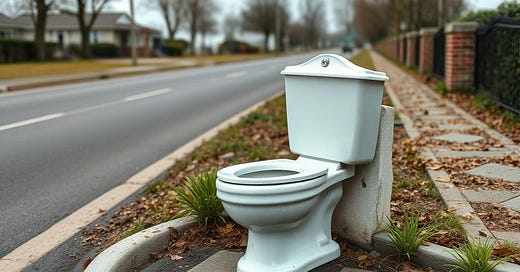Roads, Commodes… and Your Habits?
What 32 Years with a Civil Engineer Taught Me About Building a Life That Doesn’t Collapse
If someone had told me thirty-two years ago that marrying a civil engineer would change how I think about habits, I would’ve laughed.
Back then, I assumed engineers only thought about concrete and construction zones, not human behavior. But after 32 years of living with one—listening to dinner table rants about soil stability, bridge failures, and the glory of well-designed drainage systems—I see the world differently.
My husband likes to say that civil engineers are the reason modern civilization works. Roads, bridges, plumbing—without them, we’d all be stuck in mud huts. Or worse, without working toilets. That’s why, during his time in the Air Force, they affectionately called themselves “Roads and Commodes.”
But over the years, something unexpected happened. As he explained how bridges are designed to withstand wind, earthquakes, and the weight of 18-wheelers, I started to see metaphors everywhere. Especially when I was working with patients struggling to rebuild their health, habits, and hope.
I realized something: habits are bridges, too.
They connect where you are now to where you want to be. But if they’re not built right—if the foundation is shaky or the stress isn’t well-distributed—they crack under pressure. Or worse, collapse entirely.
So today, let me show you how six core engineering principles used to build the world’s strongest bridges can also be used to build your strongest, most healing habits.
1. Load Distribution: Spread the Stress
Engineering insight: A strong bridge doesn’t collapse under weight because it distributes the load. Forces like cars, wind, or even earthquakes are shared across arches, trusses, and cables.
Habit lesson: When you’re trying to change your habits, don’t let one moment carry the entire weight of success. Don’t rely on one motivation, one perfect morning routine, or one day of willpower. Build a system that supports you from all sides—community, reminders, environment, identity. Spread the load.
2. Compression and Tension: Balance the Push and Pull
Engineering insight: Compression squeezes. Tension pulls. Engineers select materials that can handle both, like steel for tension and concrete for compression.
Habit lesson: Your life will have push and pull. Some days you’ll feel squeezed by stress. Other days you’ll be pulled in a dozen directions. A healing habit system must account for both. Mindfulness practices like breathing or journaling help release tension. Boundaries and routines help with compression. You need both.
3. Redundancy: One Failure Can’t Take You Down
Engineering insight: Redundancy means if one part fails, others take over. That’s why good bridges have backup cables and multiple supports.
Habit lesson: When you’re healing, you need built-in grace. If your morning routine fails, your evening ritual can restore you. If a meditation streak ends, a walk outside can reconnect you. Redundancy isn’t weakness. It’s wisdom.
4. Rigidity and Flexibility: Bend, Don’t Break
Engineering insight: Bridges must be firm enough to stand but flexible enough to sway with wind or temperature shifts. Suspension bridges can move several feet without breaking.
Habit lesson: If your habits are too rigid, they’ll snap under pressure. Flexibility isn’t giving up—it’s adjusting course. On a hard day, a 1-minute meditation might replace a 20-minute one. A banana with peanut butter might replace a full salad. You’re still moving forward, just adjusting the path.
5. Foundation Stability: Everything Rests Here
Engineering insight: Every bridge stands on its foundation. That’s why civil engineers drill down to bedrock or build underwater caissons to anchor it.
Habit lesson: Your foundation is your identity. If you believe you’re broken or weak, no habit will stick. But if you build on “I am a habit healer”—even shaky days become solid ground. The deeper your ‘why,’ the stronger your ‘how.’
6. Efficient Use of Materials: Strength Without Waste
Engineering insight: The best bridges aren’t overbuilt. They’re optimized—strong, smart, and elegant. Engineers use only what’s necessary to create stability.
Habit lesson: Healing doesn’t require more complexity—it requires clarity. You don’t need 12-step routines, endless supplements, or apps tracking your every move. You need small, intentional actions that work. A breath. A step. A pause.
Bridging the Gap
We often think of habit change like leaping across a chasm. But it’s more like building a bridge. Bit by bit. With care and design. With foundations, flexibility, and backups.
My civil engineer taught me that what stands the test of time isn’t brute strength—it’s thoughtful structure. And that’s true in health, too.
So the next time you feel like you’re crumbling under the weight of change, remember the bridge. Better yet—be the bridge.
You’ve seen the blueprint. Now it’s time to build.
Inside The Habit Healers Mindset’s Inner Circle, you’ll turn ideas into action—and action into strength. With each weekly guide, you’ll place another stone in the bridge toward the life you deserve.
Don’t just imagine the bridge. Cross it.
Join The Inner Circle Today.






Great metaphor. It makes a lot of sense.
This is such a meaningful perspective. Thank you for sharing.